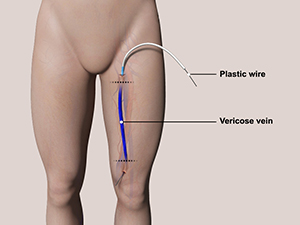Varicose Vein Surgery
 Varicose vein stripping is the surgical procedure to treat varicose veins condition. Varicose veins are the abnormal veins that appear swollen, twisted, prominent and dark purple or blue through the skin. Varicose veins can form anywhere in the body, but they are usually seen in the back of the calf or on the inside of the leg. They occur when the valves in the veins do not function properly and the blood leaks down and collects in the veins. This causes the veins to enlarge. Women are more likely to get varicose veins than men.
Varicose vein stripping is the surgical procedure to treat varicose veins condition. Varicose veins are the abnormal veins that appear swollen, twisted, prominent and dark purple or blue through the skin. Varicose veins can form anywhere in the body, but they are usually seen in the back of the calf or on the inside of the leg. They occur when the valves in the veins do not function properly and the blood leaks down and collects in the veins. This causes the veins to enlarge. Women are more likely to get varicose veins than men.
You may need vein stripping surgery for:
- Aching legs
- Varicose veins that cause poor circulation of blood (venous insufficiency)
- Ulcers or sores caused by elevated pressure in the veins
- Thrombophlebitis – Inflammation or blood clots in the veins
- Lipodermatosclerosis - Hardening of fatty tissue under the skin caused by increased blood pressure in the veins
- Cosmetic reasons
Vein stripping is generally done for removing the thickened and hardened saphenous vein (the large vein in the leg). Varicose veins are usually removed under general anaesthesia or spinal anaesthesia. The surgeon makes two small incisions, one in the groin at the top of the affected vein and the other either in your calf or ankle. The surgeon then advances a thin, flexible plastic wire through the vein from the groin incision to the incision in ankle or calf. This flexible wire is tied to the saphenous vein and pulled out bringing the entire vein with it.
For other damaged veins, tiny incisions are made over the damaged veins, and the veins are removed or tied off. The incisions are closed with sutures.
Most people are able to return to work within two weeks of the surgery. Following surgery, your surgeon may ask you to keep your legs wrapped with bandages for several weeks. Keep your leg elevated above your heart level by placing pillows or blankets under your legs. Compression stockings may be worn to improve blood flow. You may also be prescribed pain medications to reduce pain. Take several short walks, for 5 to 10 minutes each and avoid standing or sitting for prolonged periods of time.
Possible complications of vein stripping include bruising or scarring at the incision sites, nerve damage, and recurrence of varicose veins.
Surgical stripping is the last resort of treatment. Exercising, losing weight, avoiding tight clothes, elevating your legs, and avoiding long periods of standing can lessen pain and prevent varicose veins from getting worse. But, if varicose veins are painful or if you're concerned about how your veins look, your surgeon may recommend the stripping procedure.







